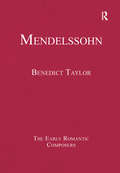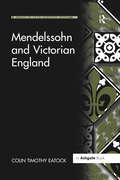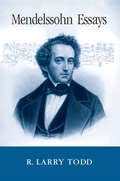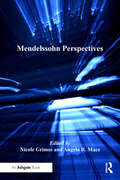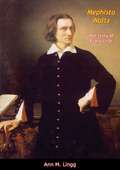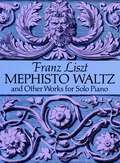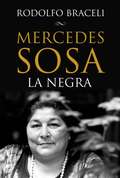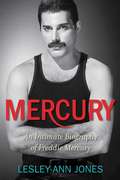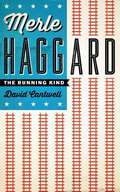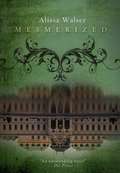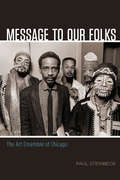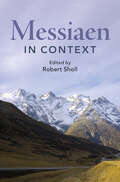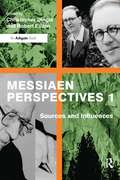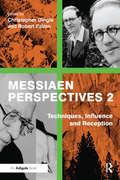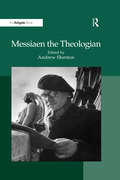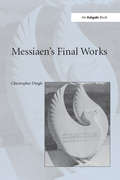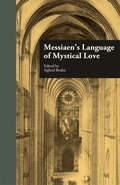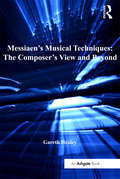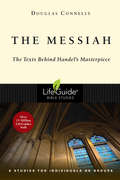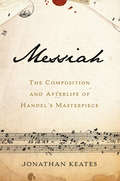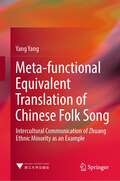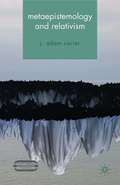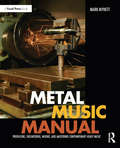- Table View
- List View
Mendelssohn: The Romantic Conception Of Cyclic Form
by Benedict TaylorThis volume of essays brings together a selection of the most significant and representative writings on Mendelssohn from the last fifty years. Divided into four main subject areas, it makes available twenty-two essays which have transformed scholarly awareness of this crucial and ever-popular nineteenth-century composer and musician; it also includes a specially commissioned introductory chapter which offers a critical overview of the last half century of Mendelssohn scholarship and the direction of future research. The addition of new translations of two influential essays by Carl Dahlhaus, hitherto unavailable in English, adds to the value of this volume which brings back in to circulation important scholarly works and constitutes an indispensable reference work for Mendelssohn scholars.
Mendelssohn and Victorian England (Music In Nineteenth-century Britain Ser.)
by ColinTimothy EatockThis valuable book considers the reception of the composer, pianist, organist and conductor Felix Mendelssohn in nineteenth-century England, and his influence on English musical culture. Despite the composer's immense popularity in the nation during his lifetime and in the decades following his death, this is the first book to deal exclusively with the subject of Mendelssohn in England. Mendelssohn's highly successful ten trips to Britain, between 1829 and 1847, are documented and discussed in detail, as are his relationships with English musicians and a variety of prominent figures. An introductory chapter describes the musical life of England (especially London) at the time of Mendelssohn's arrival and the last two chapters deal with the composer's posthumous reception, to the end of the Victorian era. Eatock reveals Mendelssohn as a catalyst for the expansion of English musical culture in the nineteenth century. In taking this position, the author challenges much of the extant literature on the subject and provides an engaging story that brings Mendelssohn and his English experiences to life.
Mendelssohn Essays: Essays On Their Music And Its Context
by R. Larry ToddWhen R. Larry Todd’s biography, Mendelssohn: A Life in Music, appeared in 2003, it won acclaim from several critics as a definitive biography. In researching Mendelssohn’s life over the last two and a half decades, Todd uncovered much new information about the composer and his music, his family and his peers, and his complex reception history. Now, as we approach the 2009 bicentenary of Mendelssohn’s birth, the author has chosen and compiled fifteen essays written between 1980 and 2005, including five previously unpublished, that examine several aspects of the composer whom Goethe and Heine likened to a second Mozart. Mendelssohn Essays explores Mendelssohn’s precocity, his musical impressions of British culture, the role of the visual in his music, his compositional response to Bach’s St. Matthew Passion, and incomplete drafts from his musical estate of three instrumental works. In addition, a group of three essays focuses on the music of Mendelssohn’s sister Fanny Hensel, perhaps the most gifted woman composer of the century, and a significant, complex figure in the formation of the Mendelssohnian style.
Mendelssohn Perspectives
by Nicole Grimes Angela R. MaceIf the invective of Nietzsche and Shaw is to be taken as an endorsement of the lasting quality of an artist, then Felix Mendelssohn Bartholdy takes pride of place beside Tennyson and Brahms in the canon of great nineteenth-century artists. Mendelssohn Perspectives presents valuable new insights into Mendelssohn’s music, biography and reception. Critically engaging a wide range of source materials, the volume combines traditional musical-analytical studies with those that draw on other humanistic disciplines to shed new light on the composer’s life, and on his contemporary and posthumous reputations. Together, these essays bring new historical and interpretive dimensions to Mendelssohn studies. The volume offers essays on Mendelssohn's Jewishness, his vast correspondence, his music for the stage, and his relationship with music of the past and future, as well as the compositional process and handling of form in the music of both Mendelssohn and his sister, the composer Fanny Hensel. German literature and aesthetics, gender and race, philosophy and science, and issues of historicism all come to bear on these new perspectives on Mendelssohn.
Mendelssohn, Time and Memory
by Benedict TaylorFelix Mendelssohn has long been viewed as one of the most historically minded composers in western music. This book explores the conceptions of time, memory and history found in his instrumental compositions, presenting an intriguing new perspective on his ever-popular music. Focusing on Mendelssohn's innovative development of cyclic form, Taylor investigates how the composer was influenced by the aesthetic and philosophical movements of the period. This is of key importance not only for reconsideration of Mendelssohn's work and its position in nineteenth-century culture, but also more generally concerning the relationship between music, time and subjectivity. One of very few detailed accounts of Mendelssohn's music, the study presents a new and provocative reading of the meaning of the composer's work by connecting it to wider cultural and philosophical ideas.
Mephisto Waltz: The Story of Franz Liszt
by Ann M. LinggBeethoven, Brahms, Schumann, Berlioz, Rossini, Wagner, Meyerbeer, Mendelssohn, Chopin, Rubinstein. These musical greats were Franz Liszt’s contemporaries and friends during his long, tempestuous, and productive life—a life lived during one of the richest periods in all musical history.Born in Austria-Hungary, Liszt learned to play the piano at an early age; he was then taken to Vienna to study under the great teacher, Czerny, Beethoven’s own pupil. Before he was fourteen, Liszt played concerts and recitals in Paris and London. Whilst still on the threshold of his fabulous career, Liszt felt dissatisfaction with his worldly life and seriously considered entering the priesthood. But this man, a failure when he lived a conventional life and successful only when wildly extravagant, became instead the leader in the fashionable musical world of Pairs—and eventually of all Europe. It was only in old age that he returned to the spiritual and became the Abbé Liszt.
Mephisto Waltz and Other Works for Solo Piano (Dover Classical Piano Music)
by Franz LisztA prolific composer and virtuoso pianist, Franz Liszt (1811-1886) was the most lionized musical personality of his time. His compositions for solo piano continue to be loved and admired by pianists and their audiences for their lush Romanticism and technical fireworks. They remain among the most frequently performed works in the repertoire. This choice selection of Liszt piano works reveals the powers at this extraordinary composer's command: Mephisto Waltz No.1; Nuages Gris; Liebesträume Nos. 1, 2 & 3; Grand Galop Chromatique; Polonaises Nos. 1 & 2; Valse-Impromptu in A-flat Major; Fantasia and Fugue on the Theme BACH; La Lugubre Gondola I & II; Valse Oubliée No. 1; Czárdás Macabre; Gretchen (from A Faust Symphony); Unstern: Sinsitre, Disastro; and Rhapsodie Espagnole.
Mercedes Sosa, La Negra (Edición definitiva)
by Rodolfo BraceliLa negra Mercedes Sosa canta su biografía. A los 67, en el 2003, decidiócontar su vida. Como no quiso simularse escritora, la suya es unabiografía en voz alta. «Mercedes Sosa. La Negra» es la edición definitiva de la única biografíaque se realizó con su palabra viva. Es así como, para un personajecomplejo y atípico, Rodolfo Braceli eligió un camino inusual. Todo subagaje de escritor, periodista, dramaturgo y poeta lo despliega en esteoriginal libro desde y sobre Mercedes Sosa. Por un lado, el relato de lasuprema cantante-cantora es la columna vertebral. Por otro, emergenvoces: la de su madre y hermanos, la de su hijo y amigos.Cada tanto aparecen, con sus recuerdos, figuras como León Gieco, HoracioMolina, Víctor Heredia, Liliana Herrero, Carlos Alonso y Charly García.Ellos completan el retrato de la otra Mercedes, la que estaba lejos delas ovaciones y muy cerca de la gente.No es todo: a la voz, por momentos en carne viva de la protagonista, sesuma en el montaje el relato de episodios dramáticos y memorables quemarcaron su vida y su carrera. Este libro que empezó a gestarse hacecasi medio siglo incluye infancia, adolescencia, despertar artístico,amores y desamores, ideología, amenazas de muerte, censura y exilio,glorioso retorno en el 82, consagración mundial, enfermedad conapetencia de suicidio en el 97, testamento. Como escribió LilianaHerrero: «Estamos ante una confesión pasional, pero también ante undocumento extraordinario. Ante un libro político y también profundamenteíntimo, público y privado, indispensable para contar la historiacultural de este país».
Mercury: An Intimate Biography of Freddie Mercury
by Lesley-Ann JonesA REVEALING, INTIMATE LOOK AT THE MAN WHO WOULD BE QUEEN As lead vocalist for the iconic rock band Queen, Freddie Mercury's unmatched skills as a songwriter and his flamboyant showmanship made him a superstar and Queen a household name. But despite his worldwide fame, few people ever really glimpsed the man behind the glittering façade. Now, more than twenty years after his death, those closest to Mercury are finally opening up about this pivotal figure in rock 'n' roll. Based on more than a hundred interviews with key figures in his life, Mercury offers the definitive account of one man's legendary life in the spotlight and behind the scenes. Rock journalist Lesley-Ann Jones gained unprecedented access to Mercury's tribe, and she details Queen's slow but steady rise to fame and Mercury's descent into dangerous, pleasure-seeking excesses-- this was, after all, a man who once declared, "Darling, I'm doing everything with everyone." In her journey to understand Mercury, Jones traveled to London, Zanzibar, and India--talking with everyone from Mercury's closest friends to the sound engineer at Band Aid (who was responsible for making Queen even louder than the other bands) to second cousins halfway around the world. In the process, an intimate and complicated portrait emerges. Meticulously researched, sympathetic yet not sensational, Mercury offers an unvarnished look at the extreme highs and lows of life in the fast lane. At the heart of this story is a man . . . and the music he loved.
Merle Haggard: The Running Kind
by David CantwellMerle Haggard has enjoyed artistic and professional triumphs few can match. He's charted more than a hundred country hits, including thirty-eight number ones. He's released dozens of studio albums and another half dozen or more live ones, performed upwards of ten thousand concerts, been inducted into the Country Music Hall of Fame, and seen his songs performed by artists as diverse as Lynryd Skynyrd, Elvis Costello, Tammy Wynette, Willie Nelson, the Grateful Dead, and Bob Dylan. In 2011 he was feted as a Kennedy Center Honoree. But until now, no one has taken an in-depth look at his career and body of work. In Merle Haggard: The Running Kind, David Cantwell takes us on a revelatory journey through Haggard's music and the life and times out of which it came. Covering the entire breadth of his career, Cantwell focuses especially on the 1960s and 1970s, when Haggard created some of his best-known and most influential music, which helped invent the America we live in today. Listening closely to a masterpiece-crowded catalogue (including songs such as "Okie from Muskogee," "Sing Me Back Home," "Mama Tried," "Working Man Blues," "Kern River," "White Line Fever," "Today I Started Loving You Again," and "If We Make It through December," among many more), Cantwell explores the fascinating contradictions-most of all, the desire for freedom in the face of limits set by the world or self-imposed-that define not only Haggard's music and public persona but the very heart of American culture.
Mesmerized
by Alissa WalserMozart's Vienna. A crucible for scientific experimentation and courtly intrigue, as Europe's finest minds vie for imperial favour. In a colourful, chaotic private hospital that echoes with the shrieks of hysterical patients, Franz Anton Mesmer is developing a series of controversial cure-alls for body and mind. When he is asked to help restore the sight of a blind musical prodigy favoured by the Empress herself, he senses that fame, and even immortality, is within his grasp. Mesmer knows that he will have to gain her trust if he is to open her eyes. But at what cost to her fragile talent? And will their intimacy result in scandal?
Mesmerized
by Alissa WalserMozart's Vienna. A crucible for scientific experimentation and courtly intrigue, as Europe's finest minds vie for imperial favour. In a colourful, chaotic private hospital that echoes with the shrieks of hysterical patients, Franz Anton Mesmer is developing a series of controversial cure-alls for body and mind. When he is asked to help restore the sight of a blind musical prodigy favoured by the Empress herself, he senses that fame, and even immortality, is within his grasp. Mesmer knows that he will have to gain her trust if he is to open her eyes. But at what cost to her fragile talent? And will their intimacy result in scandal?
Message to Our Folks: The Art Ensemble of Chicago
by Paul SteinbeckThis year marks the golden anniversary of the Art Ensemble of Chicago, the flagship band of the Association for the Advancement of Creative Musicians. Formed in 1966 and flourishing until 2010, the Art Ensemble distinguished itself by its unique performance practices—members played hundreds of instruments on stage, recited poetry, performed theatrical sketches, and wore face paint, masks, lab coats, and traditional African and Asian dress. The group, which built a global audience and toured across six continents, presented their work as experimental performance art, in opposition to the jazz industry’s traditionalist aesthetics. In Message to Our Folks, Paul Steinbeck combines musical analysis and historical inquiry to give us the definitive study of the Art Ensemble. In the book, he proposes a new theory of group improvisation that explains how the band members were able to improvise together in so many different styles while also drawing on an extensive repertoire of notated compositions. Steinbeck examines the multimedia dimensions of the Art Ensemble’s performances and the ways in which their distinctive model of social relations kept the group performing together for four decades. Message to Our Folks is a striking and valuable contribution to our understanding of one of the world’s premier musical groups.
Messiaen in Context (Composers in Context)
by Robert ShollExploring the many dimensions of Messiaen's life, thought and music, this book provides fresh perspectives on the contexts within which the composer worked, the intellectual currents that influenced him, and the influence he himself exerted on twentieth-century music. It enables a holistic understanding of this 'mondial' French composer in relation to the wider world, including his engagement with and refiguration of theology through music, the performance and reception of his work, the ways in which his aesthetics and conceptual universe have been understood by his students, and how his legacy continues to evolve. Reappraising known facts and adding new interpretations from a variety of inter-disciplinary and multi-disciplinary viewpoints, Messiaen in Context provides a fresh understanding and engagement with one of the most significant musicians of the twentieth century.
Messiaen Perspectives 1: Sources And Influences
by Robert FallonFocusing on Messiaen’s relation to history - both his own and the history he engendered - the Messiaen Perspectives volumes convey the growing understanding of his deep and varied interconnections with his cultural milieux. Messiaen Perspectives 1: Sources and Influences examines the genesis, sources and cultural pressures that shaped Messiaen’s music. Messiaen Perspectives 2: Techniques, Influence and Reception analyses Messiaen’s compositional approach and the repercussions of his music. While each book offers a coherent collection in itself, together these complementary volumes elucidate how powerfully Messiaen was embedded in his time and place, and how his music resonates ever more today. Messiaen Perspectives 1: Sources and Influences presents many new primary sources, including discussion of Messiaen’s birdsong cahiers, sketch and archival materials for his Prix de Rome entries and war-time Portique, along with performance practice insights and theological inspiration in works as diverse as Visions de l’Amen, Harawi, Timbres-durées and the organ Méditations. The volume places the composer within a broader historical and cultural framework than has previously been attempted, ranging from specific influences to more general contexts. As a centrepiece, the book includes an examination of the impact of one of the greatest influences upon Messiaen, Yvonne Loriod.
Messiaen Perspectives 2: Techniques Influence And Reception
by Robert FallonFocusing on Messiaen’s relation to history - both his own and the history he engendered - the Messiaen Perspectives volumes convey the growing understanding of his deep and varied interconnections with his cultural milieux. Messiaen Perspectives 1: Sources and Influences examines the genesis, sources and cultural pressures that shaped Messiaen’s music. Messiaen Perspectives 2: Techniques, Influence and Reception analyses Messiaen’s compositional approach and the repercussions of his music. While each book offers a coherent collection in itself, together these complementary volumes elucidate how powerfully Messiaen was embedded in his time and place, and how his music resonates ever more today. Messiaen Perspectives 2: Techniques, Influence and Reception explores Messiaen’s imprint on recent musical life. The first part scrutinizes his compositional technique in terms of counterpoint, spectralism and later piano music, while the second charts ways in which Messiaen’s influence is manifest in the music and careers of Ohana, Xenakis, Murail and Quebecois composers. The third part includes case studies of Messiaen’s reception in Italy, Spain and the USA. The volume also includes an ornithological catalogue of Messiaen’s birds, collates information on the numerous ’tombeaux’ pieces he inspired, and concludes with a Critical Catalogue of Messiaen’s Musical Works.
Messiaen the Theologian
by Andrew ShentonFor Olivier Messiaen, music was a way of expressing his faith. He considered it his good fortune to have been born a Catholic and declared that 'the illumination of the theological truths of the Catholic faith is the first aspect of my work, the noblest and no doubt the most useful'. Messiaen is one of the most widely performed and recorded composers of the twentieth-century and his popularity is increasing, but the theological component of his music has so far largely been neglected, or dealt with superficially, and continues to provide a serious impediment to understanding and appreciating his music for some of his audience. Messiaen the Theologian makes a significant contribution to Messiaen studies by providing cultural and historical context to Messiaen's theology. An international array of Messiaen scholars cover a wide variety of topics including Messiaen's personal spirituality, the context of Catholicism in France in the twentieth century, and comparisons between Messiaen and other artists such as Dante and T.S. Eliot. Interdisciplinary methodologies such as exegesis, theological studies and analysis are used to contribute to the understanding of several major works includinglairs sur l'au-del., Sept Ha nd Saint Fran‘s d'Assise. By approaching Messiaen and his music from such important and original perspectives, this book will be of interest not only to musicians and theologians, but also to readers interested in the connection between spirituality and the arts.
Messiaen's Final Works
by Christopher DingleWhen Olivier Messiaen (1908-1992) completed the vast opera Saint Fran�s d�Assise in 1983, he was mentally and physically exhausted, and believed that this monumental work would be his final compositional statement. In fact, he completed seven further works, and these form the focus of the present study. Christopher Dingle suggests that, following the crisis provoked by the opera, Messiaen's music underwent a discernible change in style. He examines these seven works to identify characteristics of the composer's music, in particular an often overlooked aspect of his technique: harmony. Part I of the book begins with a brief historical survey before discussing Saint Fran�s d�Assise as the work which defines everything that follows. Part II examines the series of miniatures that came after the opera and their links with �lairs sur l�Au-Del�., his final masterpiece. �lairs forms the subject of Part III of the book. Each movement is analysed in turn, before the work is considered as a whole and its hidden structure and motivic cohesion is revealed. Finally, Part IV considers the incomplete Concert � and key stylistic features of the works of Messiaen�s final years.
Messiaen's Language of Mystical Love
by Siglind BruhnFirst Published in 1998. Routledge is an imprint of Taylor & Francis, an informa company.
Messiaen's Musical Techniques: The Composer's View And Beyond
by Gareth HealeyDespite Messiaen's position as one of the greatest technical innovators of the twentieth century, his musical language has not been comprehensively defined and investigated. The composer's 1944 theoretical study, The Technique of My Musical Language, expounds only its initial stages, and while his posthumously published Traité de rythme, de couleur, et d'ornithologie contains detailed explanations of selected techniques, in most cases the reader is left to define these more precisely by observing them in the context of Messiaen's analyses of his own works. Technical processes are nevertheless in many cases the primary components of a work or movement. For instance, personnages dominate 'Joie du sang des étoiles' from the Turangalîla-symphonie, and in certain cases, such as 'L'échange' from the Vingt regards sur l'Enfant-Jésus, the process (asymmetric augmentation) is the only structuring element present. Given this reliance on idiosyncratic techniques, clear comprehension of the music is impossible without a detailed knowledge of Messiaen's methods. Gareth Healey charts their development and interconnections, considers their relationship with formal structures, and applies them in refined and extended form to works for which Messiaen himself left no published analysis.
The Messiah: The Texts Behind Handel's Masterpiece (LifeGuide Bible Studies)
by Douglas ConnellyProphets prophesied about him. Angels and shepherds rejoiced at his birth. Friends cried for joy at his resurrection. And we still celebrate him today. He is Jesus, the Messiah. Perfect for Advent or Lent, this eight-session LifeGuide Bible Study guide explores some of the key passages in the Old Testament about the Messiah and their completion in the life and saving work of Jesus. These passages have had a profound effect on the imagination and worship of Christians for two thousand years, leading George Frederic Handel to write one of the greatest expressions of worship and adoration—his oratorio, the Messiah. We hear parts of it sung every year during the Christmas season, but what many listeners fail to realize is that the entire text of Handel's Messiah is drawn from Scripture—and many of the Old Testament passages that shaped Israel's hope for their Redeemer are included in that text. This guide leads you through Scripture passages used in Handel's work that highlight who Jesus is and what he came to do. It might change the way you listen to the Messiah. Even more, it might change the way you live. For over three decades LifeGuide Bible Studies have provided solid biblical content and raised thought-provoking questions—making for a one-of-a-kind Bible study experience for individuals and groups. This series has more than 130 titles on Old and New Testament books, character studies, and topical studies.
Messiah: The Composition and Afterlife of Handel's Masterpiece
by Jonathan KeatesFrom Handel's renowned biographer, the story of one of the most celebrated compositions of Western classical music, Handel's famous oratorio, Messiah In the late summer of 1741, George Friderick Handel, composed an oratorio set to words from the King James Bible, rich in tuneful arias and magnificent choruses. Jonathan Keates recounts the history and afterlife of Messiah, one of the best-loved works in the classical repertoire. He relates the composition's first performances and its relationship with spirituality in the age of the Enlightenment, and examines how Messiah, after Handel's death, became an essential component of our musical canon. An authoritative and affectionate celebration of the high-point of the Georgian golden age of music, Messiah is essential reading for lovers of classical music.
Meta-functional Equivalent Translation of Chinese Folk Song: Intercultural Communication of Zhuang Ethnic Minority as an Example
by Yang YangThis book brings audiences the enchanting melodies passing down from generation to generation in the Zhuang community, which are on the brink of extinction. Specifically, it sheds light on the origin, evolution and artistic features of Zhuang folk song in the first place, and then it shifts to their English translation based on meta-functional equivalence, through which the multi-aesthetics of Zhuang folk song have been represented. At length, forty classic Zhuang folk songs have been selected, and each could be sung bilingually in line with the stave.This book benefits researchers and students who are interested in music translation as well as the Zhuang ethnic music, culture and literature. It also gives readers an insight into musicology, anthropology and intercultural study.
Metaepistemology and Relativism (Palgrave Innovations in Philosophy)
by J. CarterIs knowledge relative? Many academics across the humanities say that it is. However those who work in mainstream epistemology generally consider that it is not. Metaepistemology and Relativism questions whether the kind of anti-relativistic background that underlies typical projects in mainstream epistemology can on closer inspection be vindicated.
Metal Music Manual: Producing, Engineering, Mixing, and Mastering Contemporary Heavy Music
by Mark MynettMetal Music Manual shows you the creative and technical processes involved in producing contemporary heavy music for maximum sonic impact. From pre-production to final mastered product, and fundamental concepts to advanced production techniques, this book contains a world of invaluable practical information. Assisted by clear discussion of critical audio principles and theory, and a comprehensive array of illustrations, photos, and screen grabs, Metal Music Manual is the essential guide to achieving professional production standards. The extensive companion website features multi-track recordings, final mixes, processing examples, audio stems, etc., so you can download the relevant content and experiment with the techniques you read about. The website also features video interviews the author conducted with the following acclaimed producers, who share their expertise, experience, and insight into the processes involved: Fredrik Nordström (Dimmu Borgir, At The Gates, In Flames) Matt Hyde (Slayer, Parkway Drive, Children of Bodom) Ross Robinson (Slipknot, Sepultura, Machine Head) Logan Mader (Gojira, DevilDriver, Fear Factory) Andy Sneap (Megadeth, Killswitch Engage, Testament) Jens Bogren (Opeth, Kreator, Arch Enemy) Daniel Bergstrand (Meshuggah, Soilwork, Behemoth) Nick Raskulinecz (Mastodon, Death Angel, Trivium) Quotes from these interviews are featured throughout Metal Music Manual, with additional contributions from: Ross "Drum Doctor" Garfield (one of the world’s top drum sound specialists, with Metallica and Slipknot amongst his credits) Andrew Scheps (Black Sabbath, Linkin Park, Metallica) Maor Appelbaum (Sepultura, Faith No More, Halford)
